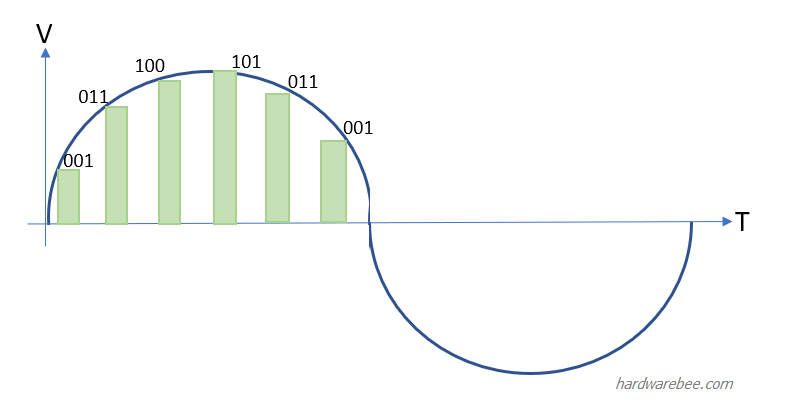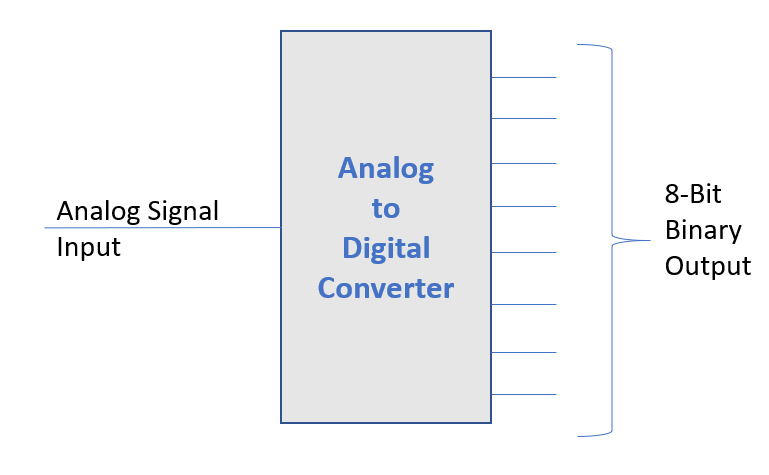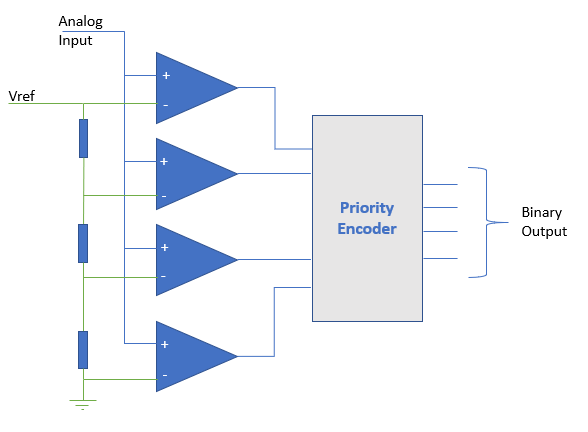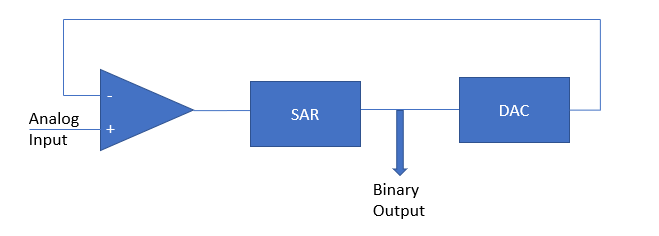Analog to Digital Converter Basics
15/06/2019, hardwarebee
Our world today is as dependent and centered on technology as it has never been before. Electronic products play a central role in ensuring that our daily life and the infrastructure we utilize are working optimally. You would not be able to operate your electronic gadgets if you did not have the circuits, converters, and devices working in the background or in the inside, making it all a possible.
Analog to digital converters, or ADCs, are very commonly used across a multitude of electronic products and are a key component on our everyday lives. In this article, we will explore the basics of analog to digital converters, how exactly they work, the different types of analog to digital converters that are available in the market today, and where each of them is used in the field.
Figure 1: An Illustration of Digital Representation of an Analog Signal
Analog to digital converters, as suggested by the name, convert analog signals into digital signals for various purposes. Analog signals are real world signals like noise, light, humidity, temperature, voltage, current, and more, using an analog to digital converters, they are converted into a digital representation of that analog signal. Hundreds and thousands of electronic equipment and devices today use analog to digital converters which take in analog signals as input, process and convert them, and produced a digital binary as the output.
Figure 2: Analog to Digital Converter Input and Output Signals
Let’s take a deeper dive into the basics and application of analog to digital converters and the purposes for which you can use them:
Analog to Digital Converter Basics
Essentially, the purpose of using any converter is to take one form of input and convert it into another form, the latter being the kind that is required for example for further processing. An analog to digital converter, hence, takes in an analog signal as input and converts it into a digital signal.
Most of the input signals that are produced in nature are analog. Take some time to think about it- sound, pressure, touch, light, and temperature amongst several others. It is difficult to work and process analog signals, therefore, there is a need for to be able to convert the analog signals into a digital binary representation to enable the processing of actual binary or numerical data. In most of the cases, an analog to digital converter is connected directly to a CPU. This means that analog signals are converted into raw digital data and given to a CPU for storage or processing.
Analog to Digital Converter Basic Operation
An analog to digital converter is a circuit that performs the rather complex task of converting analog signals into digital ones. Its job is to convert the vagueness of analog values into binary data that is measurable, allowing us to interpret a world that is primarily analog in nature. Analog to digital converters can essentially be divided into two stages:
The first stage is where we take the signal initially in order to sample and analyze it. The signal is introduced for a period of time, continuously, so that the system can hold it and derive an average of the time scale for subsequent digitization.
The next step is to determine the numerical value of the signal present at the output terminal of the circuit. This is done by referring to a set of possible values which is limited and determined by the range of the quantizer and that of the given power. The closest value for the signal is searched for in regards to the amplitude of the signal, it is assigned, and then encoded as a binary number.
As suggested, these numerical values are simply estimations or the closest possible quantity rather than exactly accurate numbers. The accuracy of the values is directly dependent on the resolution of the quantizer. The resolution of the converter can be defined as the number of individual or discrete values that can be produced by the device across a range of given analog values. It is expressed in the form of ‘n’ bits and the number of discrete values that can be produced by a quantizer is taken to be the power of two. It can also be expressed as voltage.
A higher resolution analog to digital converter means the converter will take wider samples (more bits) in less time and will therefore operate in a higher frequency. A higher resolution decreases the degree of possible error and induces a greater accuracy in the values obtained after quantization.
The next paragraphs describe the common types of analog to digital converters.
Dual Slope Analog to Digital Converter
This type of an ADC is known as the dual slope ADC because it integrates and deintegrates a voltage signal with the help of a reference voltage, Vref. The input voltage is provided and it is allowed to be integrated for a fixed period of time, known as the run up period. Next is the run down period wherein the Vref is applied, which is of a known quantity, and is allowed to ramp in the opposite polarity until the output returns to zero. The value of the unknown input voltage signal is then estimated with the help of the Vref and the run up and run down time periods.
Figure 3: Dual Slope Analog to Digital Converter Block Diagram
One of the main advantages of using a dual slope ADC is that it allows higher accuracy and it has better immunity to noise. The main disadvantage is that a dual slow ADC is relatively slow.
Flash Analog to Digital Converter
A flash or parallel ADC is a relatively fast converter, as suggested by its name. It utilizes a series of comparators that take in the input and sample it in a parallel fashion. Each comparator has a different reference voltage range which it compares the input voltage to and produces an output which will be high provided the input signal voltage exceeds the reference voltage. The signals are subsequently fed into a logic circuit or a priority encoder that generates a binary code for each voltage range at very quick speeds.
Flash ADC has fast response and therefore is used in high speed application, but it’s drawback is the number of comparators used in a flash ADC is high and therefore it’s more expensive in area, price and power consumption.
Figure 4: Flash Analog to Digital Converter Block Diagram
Successive Approximation Analog to Digital Converter
This is one of the most modern ADC solutions – it is faster and efficient as it uses a digital logic instead of analog blocks. It makes use of comparator that helps it to narrow down a range of voltages in a successive manner- a range consisting of the input voltage value. The circuit, along with having a comparator and an internal ADC, also has a successive approximation register or an SAR in which it stores the approximations that are derived after each successive step of comparing the input voltage with the midpoint of a particular voltage range generated internally.
The advantages are its capability to operate in high speed and it has good trade of between cost to performance.
Figure 5: Successive Approximation Analog to Digital Converter Block Diagram
Sigma Delta Analog to Digital Converter
The sigma delta (ΣΔ) ADC is used in various applications such as: audio and high-resolution measurement applications. The key component in a Sigma Delta ADC is the digital circuitry which consists of a digital signal processor (DSP) which acts as a low pass filter.
Sigma delta converters consist of an oversampling modulator and a decimation filter that together produce a high-resolution digital data output. The modulator samples the input signal at a high speed into a 1-bit stream. The decimation filter then takes this sampled data and converts it into a high-resolution, slower digital code.
Figure 6: Sigma Delta Analog to Digital Converter Block Diagram

















